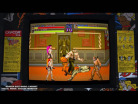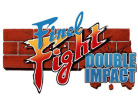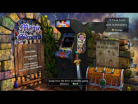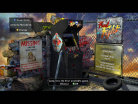- CLASSIC MAGAZINES
- REVIEW CREW
A show recapping what critics thought back
when classic games first came out! - NEXT GENERATION'S BEST & WORST
From the worst 1-star reviews to the best
5-stars can offer, this is Next Generation! - NINTENDO POWER (ARCHIVE)
Experience a variety of shows looking at the
often baffling history of Nintendo Power! - MAGAZINE RETROSPECTIVE
We're looking at the absolutely true history of
some of the most iconic game magazines ever! - SUPER PLAY'S TOP 600
The longest and most ambitious Super NES
countdown on the internet! - THEY SAID WHAT?
Debunking predictions and gossip found
in classic video game magazines! - NEXT GENERATION UNCOVERED
Cyril is back in this spin-off series, featuring the
cover critic review the art of Next Generation! - HARDCORE GAMER MAGAZING (PDF ISSUES)
Download all 36 issues of Hardcore Gamer
Magazine and relive the fun in PDF form!
- REVIEW CREW
- ELECTRONIC GAMING MONTHLY
- ELECTRONIC GAMING MONTHLY RANKS
From Mario to Sonic to Street Fighter, EGM
ranks classic game franchises and consoles! - ELECTRONIC GAMING MONTHLY BEST & WORST
Counting down EGM’s best and worst reviews
going year by year, from 1989 – 2009! - ELECTRONIC GAMING BEST & WORST AWARDS
11-part video series chronicling the ups and
downs of EGM’s Best & Worst Awards!
- ELECTRONIC GAMING MONTHLY RANKS
- GAME HISTORY
- GAME OVER: STORY BREAKDOWNS
Long-running series breaking down game
stories and analyzing their endings! - A BRIEF HISTORY OF GAMING w/ [NAME HERE]
Real history presented in a fun and pithy
format from a variety of game historians! - THE BLACK SHEEP
A series looking back at the black sheep
entries in popular game franchises! - INSTANT EXPERT
Everything you could possibly want to know
about a wide variety of gaming topics! - FREEZE FRAME
When something familiar happens in the games
industry, we're there to take a picture! - I'VE GOT YOUR NUMBER
Learn real video game history through a series
of number-themed episodes, starting at zero! - GREAT MOMENTS IN BAD ACTING
A joyous celebration of some of gaming's
absolute worst voice acting!
- GAME OVER: STORY BREAKDOWNS
- POPULAR SHOWS
- DG NEWS w/ LORNE RISELEY
Newsman Lorne Riseley hosts a regular
series looking at the hottest gaming news! - REVIEW REWIND
Cyril replays a game he reviewed 10+ years
ago to see if he got it right or wrong! - ON-RUNNING FEUDS
Defunct Games' longest-running show, with
editorials, observations and other fun oddities! - DEFUNCT GAMES QUIZ (ARCHIVE)
From online quizzes to game shows, we're
putting your video game knowledge to the test!- QUIZ: ONLINE PASS
Take a weekly quiz to see how well you know
the news and current gaming events! - QUIZ: KNOW THE GAME
One-on-one quiz show where contestants
find out if they actually know classic games! - QUIZ: THE LEADERBOARD
Can you guess the game based on the classic
review? Find out with The Leaderboard!
- QUIZ: ONLINE PASS
- DEFUNCT GAMES VS.
Cyril and the Defunct Games staff isn't afraid
to choose their favorite games and more! - CYRIL READS WORLDS OF POWER
Defunct Games recreates classic game
novelizations through the audio book format!
- DG NEWS w/ LORNE RISELEY
- COMEDY
- GAME EXPECTANCY
How long will your favorite hero live? We crunch
the numbers in this series about dying! - VIDEO GAME ADVICE
Famous game characters answer real personal
advice questions with a humorous slant! - FAKE GAMES: GUERILLA SCRAPBOOK
A long-running series about fake games and
the people who love them (covers included)! - WORST GAME EVER
A contest that attempts to create the worst
video game ever made, complete with covers! - LEVEL 1 STORIES
Literature based on the first stages of some
of your favorite classic video games! - THE COVER CRITIC
One of Defunct Games' earliest shows, Cover
Critic digs up some of the worst box art ever! - COMMERCIAL BREAK
Take a trip through some of the best and
worst video game advertisements of all time! - COMIC BOOK MODS
You've never seen comics like this before.
A curious mix of rewritten video game comics!
- GAME EXPECTANCY
- SERIES ARCHIVE
- NINTENDO SWITCH ONLINE ARCHIVE
A regularly-updated list of every Nintendo
Switch Online release, plus links to review! - PLAYSTATION PLUS CLASSIC ARCHIVE
A comprehensive list of every PlayStation
Plus classic release, including links! - RETRO-BIT PUBLISHING ARCHIVE
A regularly-updated list of every Retro-Bit
game released! - REVIEW MARATHONS w/ ADAM WALLACE
Join critic Adam Wallace as he takes us on a
classic review marathon with different themes!- DEFUNCT GAMES GOLF CLUB
Adam Wallace takes to the links to slice his way
through 72 classic golf game reviews! - 007 IN PIXELS
Adam Wallace takes on the world's greatest spy
as he reviews 15 weeks of James Bond games! - A SALUTE TO VAMPIRES
Adam Wallace is sinking his teeth into a series
covering Castlevania, BloodRayne and more! - CAPCOM'S CURSE
Adam Wallace is celebrating 13 days of Halloween
with a line-up of Capcom's scariest games! - THE FALL OF SUPERMAN
Adam Wallace is a man of steel for playing
some of the absolute worst Superman games! - THE 31 GAMES OF HALLOWEEN
Adam Wallace spends every day of October afraid
as he reviews some of the scariest games ever! - 12 WEEKS OF STAR TREK
Adam Wallace boldly goes where no critic has
gone before in this Star Trek marathon!
- DEFUNCT GAMES GOLF CLUB
- DAYS OF CHRISTMAS (ARCHIVE)
Annual holiday series with themed-episodes
that date all the way back to 2001!- 2015: 30 Ridiculous Retro Rumors
- 2014: 29 Magazines of Christmas
- 2013: 29 Questionable Power-Ups of Christmas
- 2012: 34 Theme Songs of Christmas
- 2011: 32 Game Endings of Christmas
- 2010: 31 Bonus Levels of Christmas
- 2009: 30 Genres of Christmas
- 2008: 29 Controls of Christmas
- 2007: 34 Cliches of Christmas
- 2006: 33 Consoles of Christmas
- 2005: 32 Articles of Christmas
- 2004: 31 Websites of Christmas
- 2003: 29 Issues of Christmas
- 2002: 28 Years of Christmas
- 2001: 33 Days of Christmas
- NINTENDO SWITCH ONLINE ARCHIVE
- REVIEW ARCHIVE
- FULL ARCHIVE
Final Fight: Double Impact
As I sat in front of my big-screen television playing Final Fight: Double Impact, I was struck by its authenticity. This is hardly the first time we've seen Capcom's classic brawler hit a home console. This game was used to launch the Super NES, was featured on the Sega CD and even made it to the Game Boy Advance and PSP. I own this game on at least a half dozen different consoles, yet I was sucked into this Xbox Live Arcade version like never before. Could all this be nothing more than visual effects and authentic arcade cabinet art? Whatever it was, I left Final Fight: Double Impact completely satisfied in a way I wasn't expecting.
In case you aren't familiar with Capcom's interesting business strategy, it involves the company packaging two hit arcade games into one $10 package. The A-side is Final Fight, the hugely popular 2D brawler that spawned sequels and cameos in the Street Fighter series. On the other side of the arcade is Magic Sword, a more traditional 2D action game where you run around hacking and slashing your way to the top of a very tall tower. Both games are worth paying five dollars for, especially since you can take these games online and compare your score with the online leader boards.
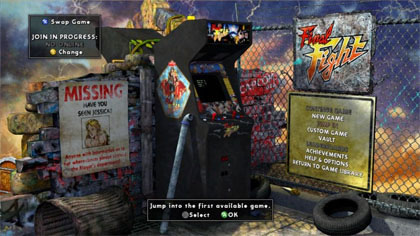
Of course, packaging two games together is nothing new. In fact, Capcom went a lot further when they released their Capcom Classic Collection games on both the PlayStation 2 and PSP. These discs featured more than a dozen games, all for not much more than Final Fight: Double Impact. But don't let the simple economics cloud your judgment, because this Xbox Live Arcade release is worth every penny you spend on it ... even if you're like me and own the game on a half dozen game systems.
The biggest draw is definitely Final Fight, a brawler that still holds up remarkably well. It's not a lengthy game; you can beat it in under an hour. This arcade game features Guy, Cody and Haggar, three tough guys who are on a mission to rescue the Mayor's daughter. Instead of hopping on a helicopter and flying straight to the gang's hideout, these three dummies decide to walk the streets, parks, subways and elevators kicking butt and cleaning up the community. Even with the short campaign, I found myself forced to continue well over twenty times. I would say that if I was actually standing in front of an arcade cabinet tossing in quarters, I would have easily spent the $5 it would have cost to buy this half of the game.
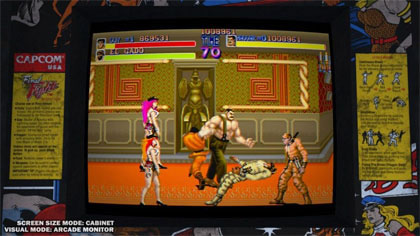
The other half is Magic Sword, which is different enough from Final Fight to be worth a play through or two. Despite being ported to everything from the Super NES to the PSP to the PlayStation 2, Magic Sword is often forgotten when people discuss classic Capcom arcade games. This game trades in the slow-pace of Final Fight for non-stop fast action. You're constantly running in one direction looking for the exit, rescuing prisoners and taking down large bosses. The levels are short and the game won't last much more than a half hour, but there's no denying how impressive all 51 levels are. And just like Final Fight, you can take this game online and play it with a friend.
Both of these arcade games are built around the idea that you are just one person in an arcade. By default a stranger can walk up to your game and join in, giving you a little help from half a world away. Of course, this means that by default you cannot pause the game. I learned about this the hard way. Because the game is constantly online (and thus open to friends and strangers), you won't be able to pause. Thankfully you can switch to an offline game and pause to your heart's content. It may seem like a minor gripe, but I wish the game mode selection was more readily apparent when you first start the game. I've heard from a number of gamers who didn't even notice that you could switch to an offline game until their second or third time playing. It's not a deal breaker, but it's definitely important to be aware of this quirky gameplay decision.
Of course, the real reason this game feels so authentic is because of the visuals. Capcom hasn't gone back and redrawn the visuals or anything, instead they have purposely made the game look as beat up as possible. Instead of simply giving you the emulated game sandwiched between a couple of black bars, Final Fight: Double Impact adds authentic cabinet art in the unused areas of your widescreen television. What's more, the game gives you a realistic looking television, one that looks like it came from 1989. The screen has a rounded shape and, depending on how you set up your visuals, you can play the game exactly how it looked in the arcades. Imperfections and all, this game successfully gives you the impression that you're playing a twenty year old arcade game.
As I sat there in front of my television set I was transported back to a time when nobody knew what high definition TVs were. It was a time when nobody cared about polygons and a 45 minute arcade game was considered a good deal. I completely forgot that I was staring at a 1080p display; instead I was transfixed on how beat-up that virtual television screen looked. I was reminded about the rounded edges and the scan lines. It all took me back to my youth in some dark and seedy arcade. It's shocking how effective all of these theatrics are, yet this would be the version I would go back to for precisely that reason.
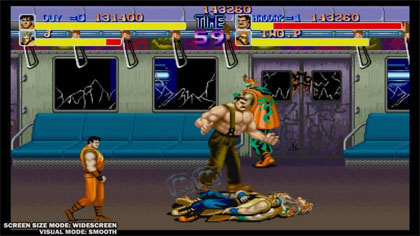
These visual effects aren't enough to make up for some outdated gameplay, but most gamers should already know what they are getting themselves in for. This is a faithful compilation of a couple ancient arcade games; you're not spending $10 for the advanced gameplay. What you're getting with this game is the very best console port, complete with useful information, achievement points and online play.
Both games also come with an in-game achievement system of sorts. As you play through each title a series of challenges will pop up, rewarding you with a series of bonus features if you complete them. This may not be enough of a reason to get you to play the game for hundreds of hours, but I found myself playing through each game for a fifth or sixth time just to see if I could complete the challenges. These challenges may be an artificial way of enhancing the game's life, but it definitely worked on me.
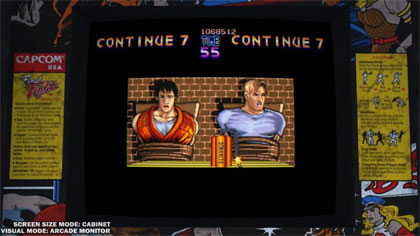
Final Fight: Double Impact may not be full of surprises, especially if you're the type of gamer who grew up on these arcade games. However, I have a hunch that there are a lot of Final Fight fans that never gave Magic Sword proper respect. Hopefully this Xbox Live Arcade release will remind people how great these arcade cabinets were. Perhaps it won't be long before we see other classic Capcom arcade games hit the system, perhaps Gun.Smoke or Strider. No matter what the future holds for Capcom, fans of classic arcade games should give Final Fight: Double Impact a shot.
HOME |
CONTACT |
NOW HIRING |
WHAT IS DEFUNCT GAMES? |
NINTENDO SWITCH ONLINE |
RETRO-BIT PUBLISHING
Retro-Bit |
Switch Planet |
The Halcyon Show |
Same Name, Different Game |
Dragnix |
Press the Buttons
Game Zone Online | Hardcore Gamer | The Dreamcast Junkyard | Video Game Blogger
Dr Strife | Games For Lunch | Mondo Cool Cast | Boxed Pixels | Sega CD Universe | Gaming Trend
Game Zone Online | Hardcore Gamer | The Dreamcast Junkyard | Video Game Blogger
Dr Strife | Games For Lunch | Mondo Cool Cast | Boxed Pixels | Sega CD Universe | Gaming Trend
Copyright © 2001-2025 Defunct Games
All rights reserved. All trademarks are properties of their respective owners.
All rights reserved. All trademarks are properties of their respective owners.






